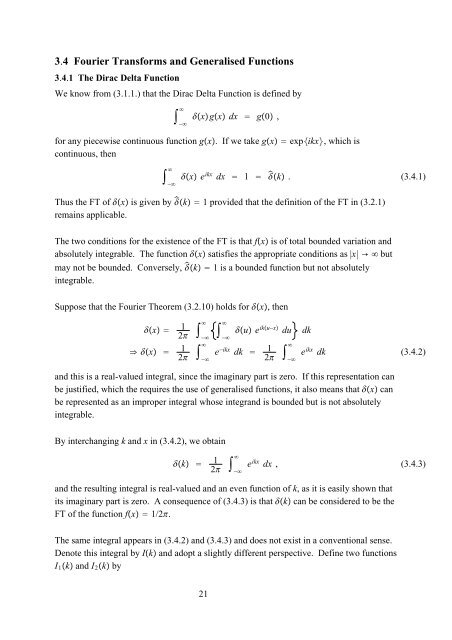Fourier Transforms
Fourier Transforms
Fourier Transforms
You also want an ePaper? Increase the reach of your titles
YUMPU automatically turns print PDFs into web optimized ePapers that Google loves.
3.4 <strong>Fourier</strong> <strong>Transforms</strong> and Generalised Functions3.4.1 The Dirac Delta FunctionWe know from (3.1.1.) that the Dirac Delta Function is defined by−xgx dx g0 ,for any piecewise continuous function gx. Ifwetakegx expikx, whichiscontinuous, then−x e ikx dx 1 k . (3.4.1)Thus the FT of x is given by k 1 provided that the definition of the FT in (3.2.1)remains applicable.The two conditions for the existence of the FT is that fx is of total bounded variation andabsolutely integrable. The function x satisfies the appropriate conditions as |x| → butmay not be bounded. Conversely, k 1 is a bounded function but not absolutelyintegrable.Suppose that the <strong>Fourier</strong> Theorem (3.2.10) holds for x, thenx 12 x 12−−−u e iku−x due −ikx dk 12−dke ikx dk (3.4.2)and this is a real-valued integral, since the imaginary part is zero. If this representation canbe justified, which the requires the use of generalised functions, it also means that x canbe represented as an improper integral whose integrand is bounded but is not absolutelyintegrable.By interchanging k and x in (3.4.2), we obtaink 12−e ikx dx , (3.4.3)and the resulting integral is real-valued and an even function of k, as it is easily shown thatits imaginary part is zero. A consequence of (3.4.3) is that k can be considered to be theFT of the function fx 1/2.The same integral appears in (3.4.2) and (3.4.3) and does not exist in a conventional sense.Denote this integral by Ik and adopt a slightly different perspective. Define two functionsI 1 k and I 2 k by21
















